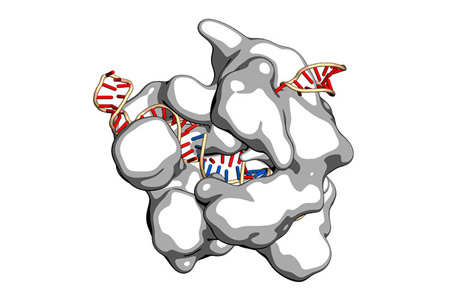Researchers at UMass Amherst have developed a new technique that greatly enhances the effectiveness of the CRISPR-Cas9 gene editing tool. The team are using nanoparticles to improve delivery of CRISPER-Cas9 across cell membranes and on to the cell nucleus where gene editing takes place.
Since 2012, when the potential of the CRISPR system for gene editing was discovered, the technique has caused much excitement in the field of molecular biology. The CRISPR system may not be to only gene editing tool, but it has a number of advantages over other techniques. Notably, it is relatively easy to use and is cheaper than alternative methods of gene editing.
Since the first tests of CRISPR were performed, scientists have been working on developing new and more efficient methods for delivering CRISPR-Cas9. While the CRISPR-Cas9 tool has been shown to be effective without the use of nanoparticles, transporting CRISPR-Cas9 across cell membranes is not always straightforward. Getting CRISPR-Cas9 into the cytosol and onto the cell nucleus has proved problematic for many researchers.
CRISPR-Cas9 can be trapped by cells’ defense mechanisms which hampers delivery. However, the new technique improves efficiency and ensures more CRISPR-Cas9 pairings make it to the cytosol.
The researchers explain that they have engineered a new version of the Cas9 enzyme – named Cas9En – and have created nanoparticles which bind to the protein and deliver it through the cell membrane. Using the new technique, the researchers claim they can achieve a 90% delivery rate with around 30% gene editing efficiency – That is a considerable improvement on other delivery methods.
According to lead researcher Rubul Mout, Ph.D., at Vincent Rotello’s laboratory at UMass Amherst, “The [Cas9En] vectors carrying the Cas9 protein and sgRNA come into contact with the cell membrane, fuse, and release the Cas9-sgRNA directly into the cell cytoplasm.” The researchers have even been able to observe the delivery process in real-time using sophisticated microscopy. As Rotello laboratory researcher Moumita Ray, Ph.D., explained, “Our method allows the precise monitoring of Cas9 protein movement inside a cell, opening new opportunities in genomic research.”
In addition to improving delivery of CRISPR-Cas9, there are other applications for the nanoparticles. They could, for instance, be used to deliver self-assembling peptides or polymers into cells.
Now that the technique has been shown to be effective in cultured cells, the team aims to conduct trials in pre-clinical animal models.
The technique is detailed in the paper Direct Cytosolic Delivery of CRISPR/Cas9-Ribonucleoprotein for Efficient Gene Editing, which has recently been published in the journal ACS Nano.
